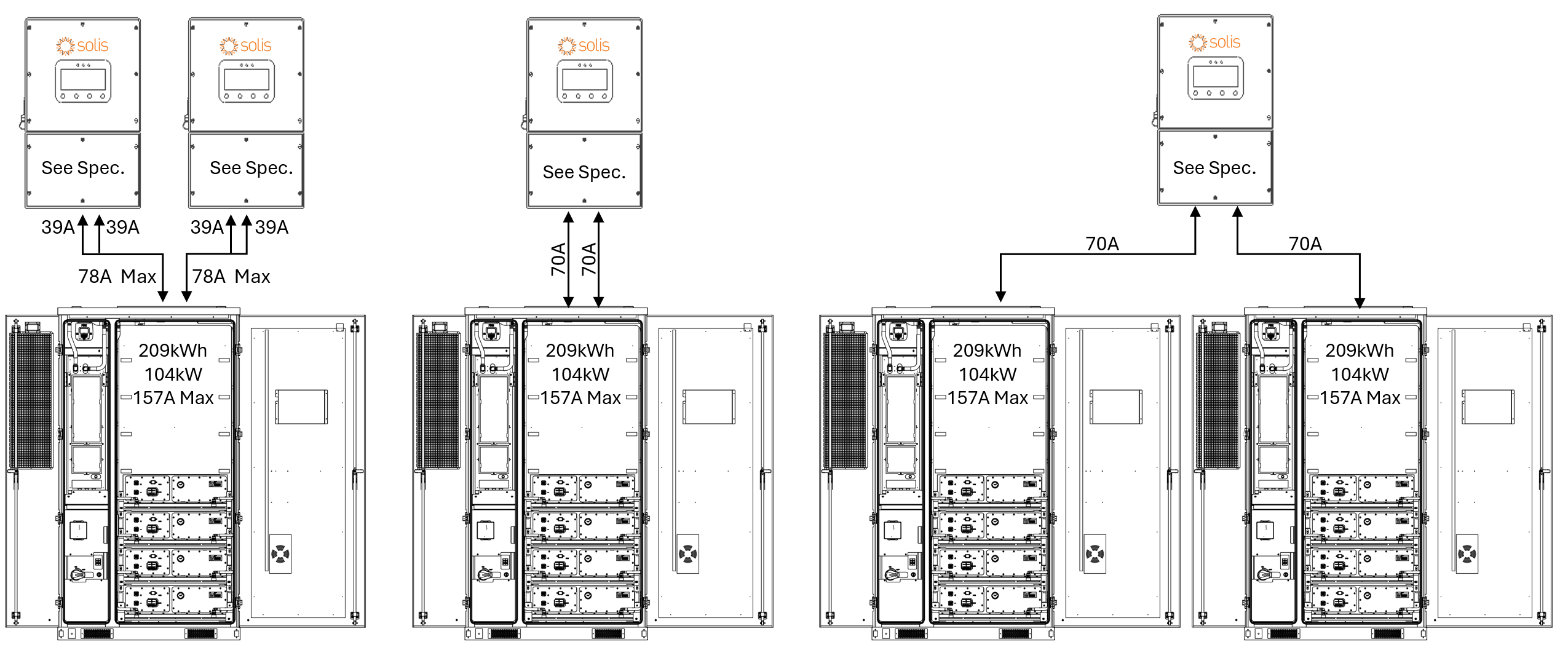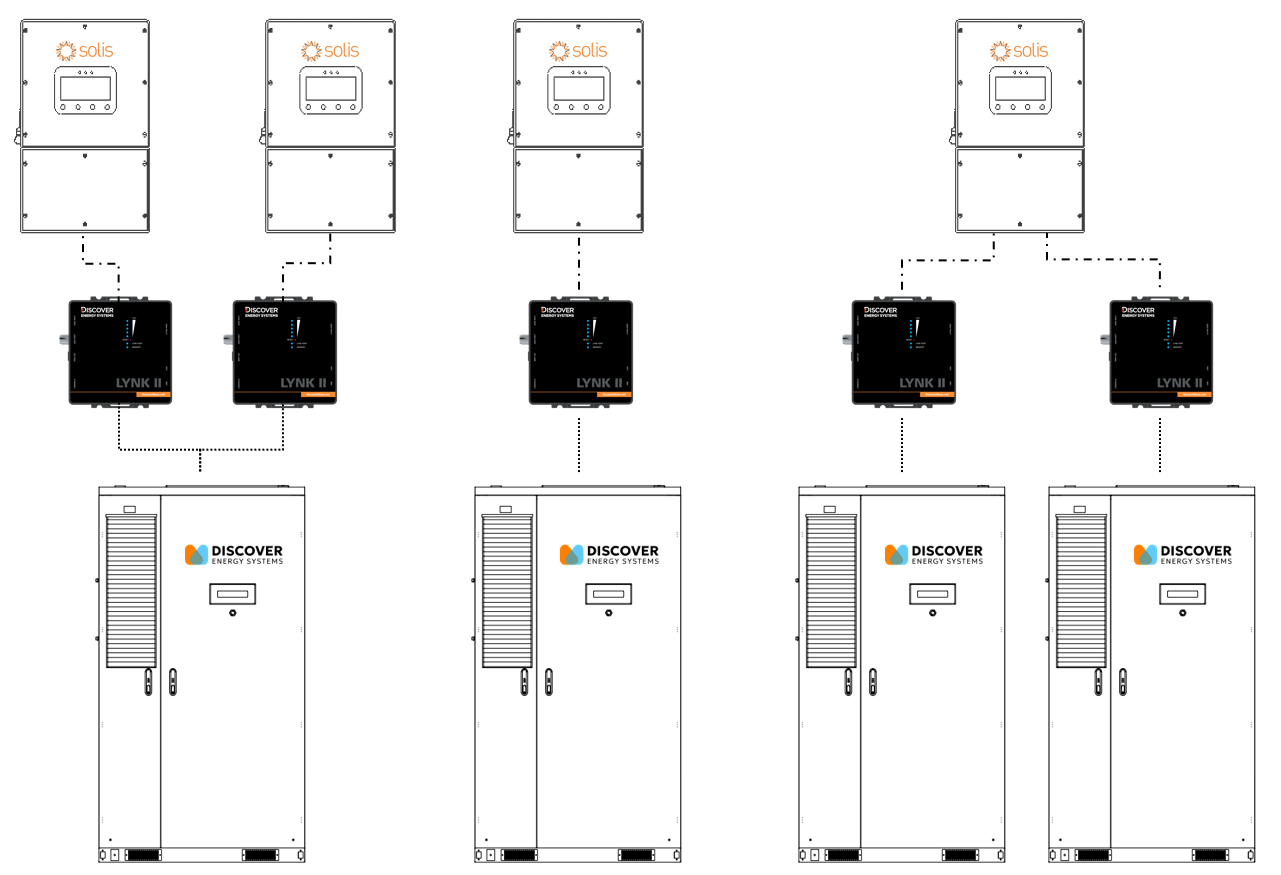Capacity and Configuration (Paralleling)
NOTICE |
|---|
EQUIPMENT DAMAGE |
Do Not Parallel Battery Cabinets on the DC Bus
Each AES 210 HV cabinet is designed to operate independently and must connect to a dedicated inverter input. Do not combine or parallel the DC outputs of multiple cabinets, as this will result in unbalanced current flow, system instability, and equipment damage.
Parallel Inverters on the AC Bus
System scalability is achieved by paralleling inverters on the AC bus, not by paralleling the batteries. In this design, each inverter has a dedicated battery cabinet, and the inverter AC outputs are synchronized to support larger system loads. This ensures safe, stable, and balanced operation across all components.
Solis S6-EH3P Hybrid inverters offer unlimited scalability on the grid side, allowing the integration of multiple units for high-capacity PV and grid-interactive applications. However, parallel operation on the islanded backup side is limited to six inverters.

Output of Solis Inverters in Backup
Model | 1 Unit | 2 Units | 3 Units | 4 Units | 5 Units | 6 Units |
|---|---|---|---|---|---|---|
S6-EH3P30K03-LV-YD-H-US | 72.2 A | 144.4 A | 216.6 A | 288.8 A | 361.0 A | 433.2 A |
S6-EH3P30K03-NV-YD-H-US | 39.7 A | 79.4 A | 119.1 A | 158.8 A | 198.5 A | 238.2 A |
S6-EH3P60K04-NV-YD-H-US | 72.2 A | 144.4 A | 216.6 A | 288.8 A | 361.0 A | 433.2 A |
NOTE |
|---|
For detailed instructions on paralleling multiple units, consult the Solis Commercial Three-Phase HV Hybrid Inverter Manual. |
Compatible Inverter Models and Specifications
Inverter Model | Max Power (PV/AC/Battery) |
|---|---|
S6-EH3P30K03-LV-YD-H-US | 59.8 / 30 / 33 kW |
S6-EH3P30K03-NV-YD-H-US | 59.8 / 30 / 33 kW |
S6-EH3P60K04-NV-YD-H-US | 96.0 / 60 / 60 kW |
When pairing one AES 210HV cabinet with a single Solis inverter, discharge performance is governed by the inverter's battery input rating, which ranges by model from 33 kW to 60 kW. The AES 210HV supports continuous output up to 106 kW (C/2 rate), so battery performance will scale according to inverter limitations:
Inverter Model | Max Discharge Power |
|---|---|
S6-EH3P30K03-LV-YD-H-US | 30 kW |
S6-EH3P30K03-NV-YD-H-US | 30 kW |
S6-EH3P60K04-NV-YD-H-US | 60 kW |
Systems can be configured with either one battery per inverter or two batteries sharing a single inverter. In all cases, the battery remains within specification. Final system sizing should align with the site’s load profile and desired runtime to ensure optimal performance and value.
Charge and Discharge Current

Inverter Current and Power Limitation
The Solis S6-EH3P inverter has two battery input terminals, each rated for up to 70 A, for a combined maximum of 140 A. When paired with the AES 210HV (665 VDC nominal), actual current is limited by the inverter’s 60 kW power rating, resulting in approximately 45 A per terminal under normal operation.
The only scenario where the battery is the limiting factor is when two 60 kW inverters are connected to a single AES 210HV cabinet. In this case, the cabinet’s maximum continuous output of 104 kW (157 A) must be shared between the two inverters; distributed across four fused conductors, with two going to each inverter.
Closed-Loop CANbus Connection - LYNK II Gateway

The LYNK II Gateway enables real-time, closed-loop communication between the AES 210HV battery and the Solis inverter. It transmits key battery data such as state of charge, voltage, current, temperature, and operating limits directly to the inverter. This allows the inverter to automatically adjust charging and discharging behavior for safe, efficient, and optimized system performance.
NOTICE |
|---|
EQUIPMENT DAMAGE |
